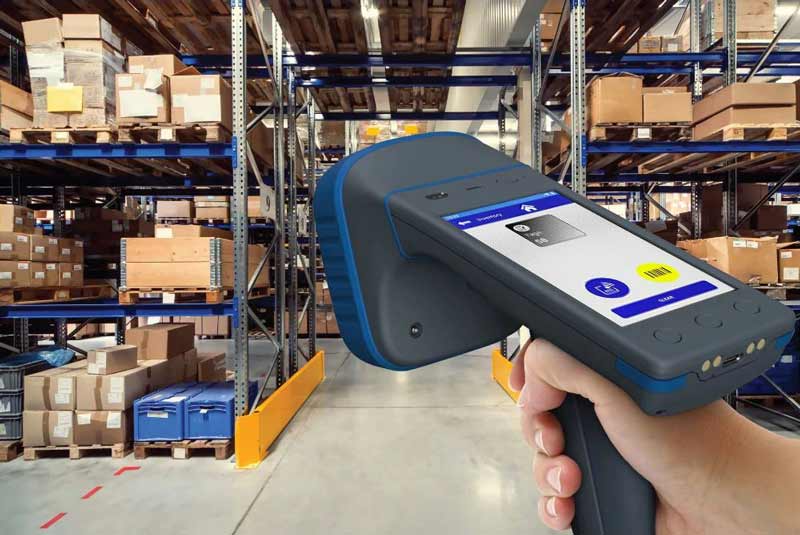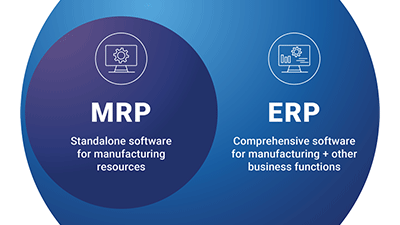Traceability in Manufacturing:
What it is and why it matters
By implementing modern methods of identification, companies are unlocking a level of visibility into their operations that takes manufacturing traceability from a pen-and-paper tracking exercise to a competitive differentiator. Advanced labeling technologies, business and machine integration, and powerful data analytics enable actionable insights that lead to greater efficiency, increased revenue and higher profits.
Manufacturing traceability can be a pretty broad category. In this blog we’ll discuss:
- What manufacturing traceability is
- Why traceability in manufacturing is important
- The benefits of manufacturing traceability
- How manufacturing traceability and Industry 4.0 intertwine
What is manufacturing traceability?
Traceability in manufacturing is the ability to track materials, parts and products (individual, batch, lot, shipment) throughout the manufacturing process and into the supply chain. It’s come a long way since the days of manual tracking and hand-kept records. Barcode technology was a game-changer, giving manufacturers the ability to track anything a barcode could be associated with, including raw materials, components, subcomponents and finished products.
Today’s manufacturing tracking systems help companies ensure quality, improve efficiency and maintain compliance using sophisticated barcode, RFID and data analytics technologies that give them real-time production traceability — insight into production processes, not just physical items — from the moment raw materials and parts enter their operational stream until finished products leave the facility.
Why traceability in manufacturing is important
As the saying goes, an ounce of prevention is worth a pound of cure. There are myriad benefits to adopting robust manufacturing traceability tools, technologies and processes, including:
Production Efficiency
Knowing precisely how materials, parts and products move through the manufacturing process improves inventory forecasting, maximizes equipment and labor utilization, minimizes inventory shrinkage, and reduces the cost of scrap, rework and recalls – all of which make over production more consistent, efficient and cost-effective. That 360-degree view also helps manufacturers guard against costly workflow disruptions. Data can be embedded in barcode labels and RFID tags to direct next steps in an automated production process. Real-time location systems (RTLS) can be deployed to quickly locate critical manufacturing items.
Regulatory compliance
Product traceability isn’t optional in many industries, especially those that are highly regulated, such as food, medical, automotive and defense. Stricter regulations and certification requirements mean more oversight, more audits and more opportunities for a recall – in short, more risk. Stringent labeling standards are often mandated, such as the markings required on items sold to the U.S. Department of Defense (MIL-STD-130 markings). Time-consuming, manual track-and-trace methods simply aren’t cost effective, especially in complex production scenarios that involve multiple suppliers, supply chain partners and distribution channels.
Risk mitigation
Product traceability is essential in industries subject to recalls. Being able to pinpoint the source, history and distribution of raw materials, parts and finished products enables manufacturers to quickly identify and isolate issues, and to use data analytics to avert similar challenges later. The ability to see and solve for potential problems proactively helps companies avoid unplanned (and sometimes quite substantial) expenses and long-term damage to the reputation of their brand.
Quality control
Production traceability begins with capturing data. And not just any data – meaningful information that not only provides valuable information, but products valuable insights. Anything that a barcode label or RFID tag can be attached to is an opportunity to impart and gather information about a material, part or product. They can store a range of data, from print and point of origin to certifications, tolerances and material handling. They can also be used to track objects at touchpoints throughout the manufacturing process, which helps people locate them, find out where they’ve been or assess the impact of changes to a workflow.
Production efficiency
Knowing precisely how materials, parts and products move through the manufacturing process improves inventory forecasting, maximizes equipment and labor utilization, minimizes inventory shrinkage, and reduces the cost of scrap, rework and recalls – all of which make over production more consistent, efficient and cost-effective. That 360-degree view also helps manufacturers guard against costly workflow disruptions. Data can be embedded in barcode labels and RFID tags to direct next steps in an automated production process. Real-time location systems (RTLS) can be deployed to quickly locate critical manufacturing items.
Regulatory compliance
Product traceability isn’t optional in many industries, especially those that are highly regulated, such as food, medical, automotive and defense. Stricter regulations and certification requirements mean more oversight, more audits and more opportunities for a recall – in short, more risk. Stringent labeling standards are often mandated, such as the markings required on items sold to the U.S. Department of Defense (MIL-STD-130 markings). Time-consuming, manual track-and-trace methods simply aren’t cost effective, especially in complex production scenarios that involve multiple suppliers, supply chain partners and distribution channels.
Risk mitigation
Product traceability is essential in industries subject to recalls. Being able to pinpoint the source, history and distribution of raw materials, parts and finished products enables manufacturers to quickly identify and isolate issues, and to use data analytics to avert similar challenges later. The ability to see and solve for potential problems proactively helps companies avoid unplanned (and sometimes quite substantial) expenses and long-term damage to the reputation of their brand.
Quality control
Manufacturing tracking systems use real-time data from connected devices to provide a holistic, 360-degree view of operations for faster problem identification and continuous process improvement. They reduce the “cost of quality” (dollars spent preventing, identifying or fixing problems/defects) by automating and speeding up data collection and analysis, audits, inspections, tests, appraisals and other activities—tasks that used to be manual, and thus more sporadic and prone to human error. These systems are also invaluable in reducing work in progress (WIP) for lean manufacturing.
The benefits of manufacturing traceability
Production traceability begins with capturing data. And not just any data — meaningful information that not only provides valuable information, but produces valuable insights. Anything that a barcode label or RFID tag can be attached to is an opportunity to impart and gather information about a material, part or product. They can store a range of data, from price and point of origin to certifications, tolerances and material handling. They can also be used to track objects at touchpoints throughout the manufacturing process, which helps people locate them, find out where they’ve been or assess the impact of changes to a workflow.
Manufacturing tracking systems that gather data in real-time enable companies to make fast, accurate, data-driven decisions using powerful data analytics software. Analytics also provide a way to troubleshoot manufacturing issues and test ways to avoid them in the future without slowing production. In addition, maintaining a database of accurate genealogies makes it possible to understand historical patterns and use them as a springboard to process improvement.
The real-time data and analytics that automated internal traceability systems provide make all types of production and business forecasting more accurate: inventory, equipment, labor, process change, profitability, etc. It also provides origin, location and genealogical accuracy when it matters most to prevent or limit liability. Manual data gathering and analysis aren’t as timely or accurate, and they don’t lend themselves to the collaboration that easily shareable data and “one version of the truth” reporting make possible.
Optimal manufacturing processes are a strong selling point for customers. So are production agility and flexibility. Manufacturing traceability enables all three and can be a true competitive differentiator. The analytics capabilities of production traceability software and applications also give companies in growth mode a way to test for scalability, process change and new equipment without interrupting operations.
Operational efficiency is at the core of profitability, and modern manufacturing tracking systems put more profit improvement levers at a company’s disposal, from production efficiency opportunities to quality control measures. As noted earlier, production traceability also limits the financial risk of regulatory noncompliance, theft and recalls.
Robust data
Production traceability begins with capturing data. And not just any data — meaningful information that not only provides valuable information, but produces valuable insights. Anything that a barcode label or RFID tag can be attached to is an opportunity to impart and gather information about a material, part or product. They can store a range of data, from price and point of origin to certifications, tolerances and material handling. They can also be used to track objects at touchpoints throughout the manufacturing process, which helps people locate them, find out where they’ve been or assess the impact of changes to a workflow.
Powerful analytics
Manufacturing tracking systems that gather data in real-time enable companies to make fast, accurate, data-driven decisions using powerful data analytics software. Analytics also provide a way to troubleshoot manufacturing issues and test ways to avoid them in the future without slowing production. In addition, maintaining a database of accurate genealogies makes it possible to understand historical patterns and use them as a springboard to process improvement.
Better accuracy
The real-time data and analytics that automated internal traceability systems provide make all types of production and business forecasting more accurate: inventory, equipment, labor, process change, profitability, etc. It also provides origin, location and genealogical accuracy when it matters most to prevent or limit liability. Manual data gathering and analysis aren’t as timely or accurate, and they don’t lend themselves to the collaboration that easily shareable data and “one version of the truth” reporting make possible.
Revenue opportunities
Optimal manufacturing processes are a strong selling point for customers. So are production agility and flexibility. Manufacturing traceability enables all three and can be a true competitive differentiator. The analytics capabilities of production traceability software and applications also give companies in growth mode a way to test for scalability, process change and new equipment without interrupting operations.
Profitability levers
Operational efficiency is at the core of profitability, and modern manufacturing tracking systems put more profit improvement levers at a company’s disposal, from production efficiency opportunities to quality control measures. As noted earlier, production traceability also limits the financial risk of regulatory noncompliance, theft and recalls.
Manufacturing traceability and Industry 4.0
Industry 4.0 — also known as smart manufacturing and intelligent manufacturing — relies on real-time data from product identification technology, connected (IoT enabled) equipment and devices, and the analytics software that enables companies to make smart, data-driven decisions that can revolutionize their manufacturing operations.
In addition to the production traceability associated with materials, parts and finished products, state-of-the-art Industry 4.0 manufacturing tracking systems use smart sensors, artificial intelligence, machine learning and advanced data management software to powerful effect. These manufacturing traceability systems are even capable of making autonomous decisions that optimize equipment and processes.


